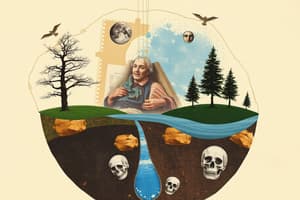Podcast
Questions and Answers
What technique did Neo-Impressionism rely on?
What technique did Neo-Impressionism rely on?
- Cubism
- Pointillism (correct)
- Fauvism
- Art Nouveau
Who is credited with recording optical sensations in a scientific manner through pointillism?
Who is credited with recording optical sensations in a scientific manner through pointillism?
- Vincent van Gogh
- Claude Monet
- Georges Seurat (correct)
- Paul Cezanne
What effect does Pointillism aim to achieve?
What effect does Pointillism aim to achieve?
- Surrealism
- Impressionism
- Realism
- Optical blending (correct)
Which art movement is considered a response to the empirical realism of Impressionism?
Which art movement is considered a response to the empirical realism of Impressionism?
What type of lines are characteristic of Art Nouveau?
What type of lines are characteristic of Art Nouveau?
Which artist is associated with the introduction of Cubism?
Which artist is associated with the introduction of Cubism?
What art movement rejected traditional renderings of three-dimensional space?
What art movement rejected traditional renderings of three-dimensional space?
Which movement's influence spread beyond Europe to Russia?
Which movement's influence spread beyond Europe to Russia?
What is the term coined by Filippo Tommaso Marinetti to reflect his artistic vision?
What is the term coined by Filippo Tommaso Marinetti to reflect his artistic vision?
What is the focus of Futurist art and poetry?
What is the focus of Futurist art and poetry?
In which country did Futurism originate?
In which country did Futurism originate?
What style of painting emerged in the mid-to late 1800s in France?
What style of painting emerged in the mid-to late 1800s in France?
What was a distinctive characteristic of Impressionist paintings?
What was a distinctive characteristic of Impressionist paintings?
What influenced the themes and techniques of Realism?
What influenced the themes and techniques of Realism?
What was a result of artists working within the context of revolutions and social changes?
What was a result of artists working within the context of revolutions and social changes?
What was a key feature of Realist art?
What was a key feature of Realist art?
What was a result of the shift towards Realism and Impressionism?
What was a result of the shift towards Realism and Impressionism?
Flashcards
Impressionism
Impressionism
Emerged in mid-to-late 1800s France, breaking away from traditional European painting.
Characteristics of Impressionism
Characteristics of Impressionism
A style emphasizing communication through brushstrokes, color distinction, and light and shadow use, incorporating scientific principles for color representation.
Realism
Realism
Revolutionized themes and techniques in paintings, focusing on accuracy of details and depicting reality.
Post-Impressionism
Post-Impressionism
Signup and view all the flashcards
Neo-Impressionism
Neo-Impressionism
Signup and view all the flashcards
Pointillism
Pointillism
Signup and view all the flashcards
Cubism
Cubism
Signup and view all the flashcards
Art Nouveau
Art Nouveau
Signup and view all the flashcards
Characteristics of Art Nouveau
Characteristics of Art Nouveau
Signup and view all the flashcards
Fauvism
Fauvism
Signup and view all the flashcards
Fauvism's Space
Fauvism's Space
Signup and view all the flashcards
Futurism
Futurism
Signup and view all the flashcards
Study Notes
Romanticism and the Emergence of New Art Movements
- Revolutionary movements became the focal point of most Romantic works.
- Impressionism, a style of painting that emerged in mid-to-late 1800s France, broke away from traditional European painting.
Characteristics of Impressionism
- Emphasizes the artist's communication through brushstrokes, color distinction, and light and shadow use.
- Incorporated scientific principles to achieve a distinct representation of color.
Realism
- Revolutionized themes and techniques in paintings.
- Influenced by Hellenistic Greek culture, emphasizing the human body.
- Focused on the accuracy of details, depicting reality.
Post-Impressionism
- Led to the development of individual styles, emphasizing defining form with broken colors and short strokes.
- Artists included Paul Cezanne, Georges Seurat, Paul Gauguin, and Vincent van Gogh.
- Emerged in France, influenced by and rejecting Impressionism.
Neo-Impressionism
- Rely on systematic and scientific techniques to achieve predetermined visual effects.
- Pointillism, a technique used by Georges Seurat, utilized discrete dots and ashes of pure color to blend with the viewer's perspective.
Cubism
- Had a huge influence on 20th-century artists.
- Introduced by Pablo Picasso and Georges Braque between 1907 and 1914.
- Highlighted the two-dimensional surface of the picture plane, rejecting dominant techniques like perspective and foreshortening.
Art Nouveau
- Uses long and organic lines, manifested in architecture, jewelry, and glass design.
- Emerged in Europe and the United States between 1890 and 1910, breaking from Conservative historicism.
Characteristics of Art Nouveau
- Asymmetrical lines, often in the form of insect wings or flower stalks.
- Lines are done in a graceful and elegant manner, evoking a certain power.
Fauvism
- Emerged in France around the turn of the 20th century.
- Characterized by a strong and expressive reaction to subjects, using pure and vibrant colors.
- Rejected conservative and traditional renderings of three-dimensional space, introducing a picture space defined by color movement.
Futurism
- Emerged in early 20th-century Italy, highlighting the speed, energy, dynamism, and power of machines.
- Coined by Filippon Tommaso Marinette, who believed art should embrace and embody change, innovation, and creativity.
- Had a significant impact on poetry and visual arts, branching out to Europe and Russia.
Studying That Suits You
Use AI to generate personalized quizzes and flashcards to suit your learning preferences.




